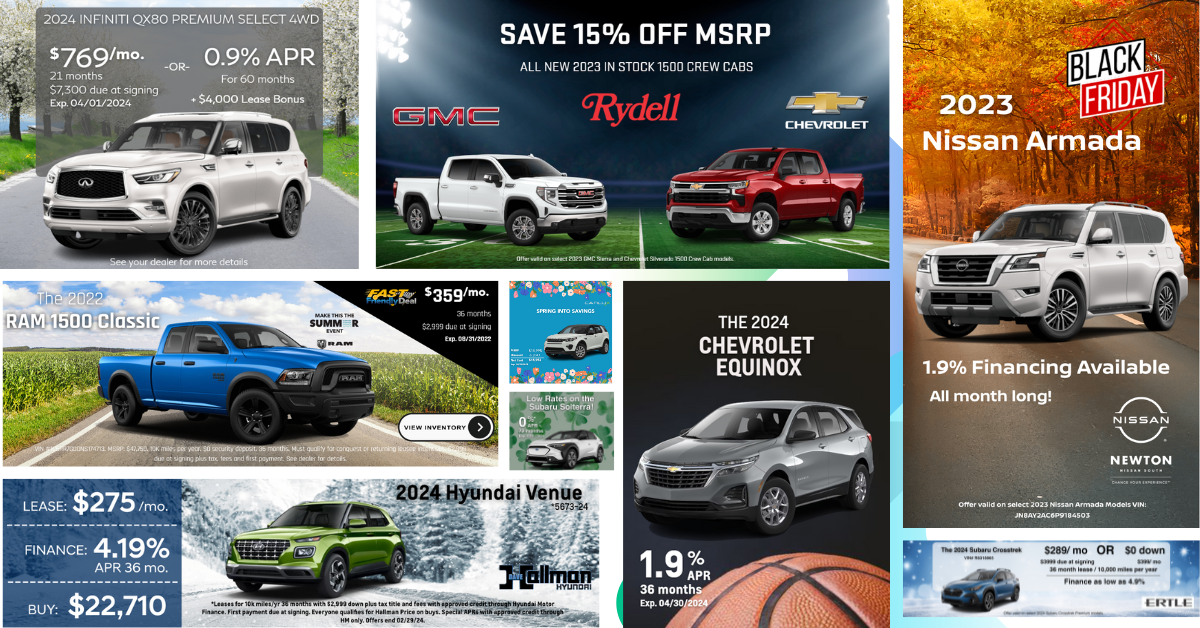Marketing a dealership isn’t just about running ads—it’s a constant battle against rising costs, slow execution, and outdated strategies. Every week, marketing teams juggle budget allocation, creative production, and multi-channel execution, all while ensuring their messaging stays consistent and their inventory gets in front of the right shoppers. But without the right tools, dealers often waste money, time, and opportunities.
Here’s a breakdown of the biggest marketing challenges dealerships face on a weekly and monthly basis—and how they can be addressed.
1. The Struggle to Get Ads Live Quickly
 Industry Insight: 65% of auto shoppers say they make a purchase decision within two weeks of starting their research online—making speed-to-market more critical than ever.
Industry Insight: 65% of auto shoppers say they make a purchase decision within two weeks of starting their research online—making speed-to-market more critical than ever.
(Source: Cox Automotive Car Buyer Journey Study, 2024)
Challenge: Dealers that lose just three days a month from when sale events are released to when ads go live are missing out on a month of impressions and opportunities to reach active buyers in their PMA. Slow creative turnaround, manual ad setups, and dependency on external vendors delay marketing efforts—giving competitors a head start and reducing campaign impact.
Solution: Dealerships seeing success have streamlined their creative process and empowered in-house teams with tools that allow same-day or next-day campaign launches. Speed to market has become a competitive advantage. For example, some stores now pre-build creative frameworks for common events like holiday sales, allowing them to swap offers and go live within hours. Others have adopted rapid-approval workflows where decision-makers are looped in early to avoid delays. Dealerships seeing success have streamlined their creative process and empowered in-house teams with tools that allow same-day or next-day campaign launches. Speed to market has become a competitive advantage.
2. Wasted Ad Spend and Budget Allocation
 Industry Insight: In 2024, more than 50% of dealership marketers said reallocating ad spend based on real-time inventory and demand led to better ROI.
Industry Insight: In 2024, more than 50% of dealership marketers said reallocating ad spend based on real-time inventory and demand led to better ROI.
(Source: Borrell Associates, Automotive Advertising Outlook, 2024)
Challenge: Dealerships often spread their budgets too thin across multiple platforms without clear data on what's performing. Budgeting is typically done monthly or quarterly, but inventory and buyer demand change daily. This leads to rigid marketing plans, wasted dollars on underperforming tactics, and missed opportunities to shift resources where they’re needed most. Dealers often find themselves promoting vehicles that have already sold or underinvesting in high-interest models that need exposure.
Solution: Top-performing dealerships monitor performance regularly and stay flexible. They reallocate budget based on vehicle demand, campaign performance, and monthly sales goals—choosing impact over tradition. Some set aside a flexible portion of their budget each month for inventory pushes, while others rely on heat maps and sales data to guide reallocations. Weekly marketing reviews help teams identify what’s working and make quick decisions to adjust spend accordingly.
3. Keeping Brand Messaging Consistent Across Platforms
 Fun Fact: 75% of consumers say consistent messaging across channels makes a brand appear more trustworthy.
Fun Fact: 75% of consumers say consistent messaging across channels makes a brand appear more trustworthy.
(Source: Salesforce State of Marketing Report, 2024)
Challenge: When multiple vendors or team members handle creative and campaign execution, messaging can become fragmented. Promotions lose clarity, dealership voice gets diluted, and the overall brand experience suffers across different platforms.
Solution: Dealers with the strongest brand presence keep messaging centralized. They use shared templates, review creative before launch, and ensure all ads reflect current incentives and seasonal messaging. For instance, some stores use internal brand guidelines and creative checklists to maintain consistency across teams. Others have one designated marketing lead who oversees cross-channel execution. Dealers with the strongest brand presence keep messaging centralized. They use shared templates, review creative before launch, and ensure all ads reflect current incentives and seasonal messaging.
4. Adapting to Emerging Marketing Trends
 Fun Fact: Memes and GIFs still have a place in dealership marketing, but short-form video continues to dominate—87% of marketers in 2024 said it drove higher engagement than any other format.
Fun Fact: Memes and GIFs still have a place in dealership marketing, but short-form video continues to dominate—87% of marketers in 2024 said it drove higher engagement than any other format.
(Source: Wistia Video Marketing Benchmark Report, 2024)
Challenge: Social media algorithms shift, consumer behavior evolves, and new platforms emerge regularly. Staying relevant means constant adjustment—but many dealerships lack the bandwidth or tools to adapt quickly and effectively.
Solution: Dealers ahead of the curve keep an eye on trends, test new formats, and learn from performance fast. They dedicate time to exploring what’s next without abandoning what’s working now. For example, some experiment with video shorts and seasonal Instagram Reels, while others test out new ad formats like interactive lead forms or dynamic carousels tied to promotions. Dealers ahead of the curve keep an eye on trends, test new formats, and learn from performance fast. They dedicate time to exploring what’s next without abandoning what’s working now.
5. Bridging Digital and Traditional Marketing
 Fun Fact: 68% of consumers in 2024 said campaigns that appear both online and offline feel more credible and memorable.
Fun Fact: 68% of consumers in 2024 said campaigns that appear both online and offline feel more credible and memorable.
(Source: ThinkTV + Ipsos, Cross-Media Impact Study, 2024)
Challenge: Many dealers still rely on traditional media like radio, direct mail, and local print, but integrating these with digital strategies can create workflow bottlenecks and inconsistencies in messaging. In a digital-first era, it’s easy to overlook the lasting value of traditional channels, even though they continue to resonate in many communities—especially where digital saturation is low or local brand equity is strong.
Solution: Dealers who succeed at bridging the gap maintain a unified calendar, align messaging across channels, and use digital to enhance traditional. For instance, a dealership might pair a direct mail service offer with social retargeting, or mirror radio promotions with dynamic display ads. Some stores repurpose TV content into Instagram Reels, while others use traditional formats to drive awareness and digital tools to track and convert. As more dealers shift toward Connected TV and Streaming Audio, the key is pairing reach with measurable performance.
6. Standing Out from the Competition
 Fun Fact: In 2025, 84% of car buyers said a dealership's digital presence directly influenced where they purchased.
Fun Fact: In 2025, 84% of car buyers said a dealership's digital presence directly influenced where they purchased.
(Source: CDK Global Automotive Retail Insights, 2025)
Challenge: With so many vendors offering generic solutions, dealerships struggle to find tools that truly align with the day-to-day pace and unique demands of automotive retail. This often leads to reliance on inefficient systems that weren’t designed with dealership workflows in mind.
Solution: The most successful stores lean into tools and partners built specifically for automotive. They prioritize efficiency, creativity, and ease of use—choosing platforms that work at their speed and scale. Some dealerships have adopted centralized platforms that combine creative and media under one roof, while others focus on partners who offer flexible terms and automotive-specific campaign strategies. The most successful stores lean into tools and partners built specifically for automotive. They prioritize efficiency, creativity, and ease of use—choosing platforms that work at their speed and scale.
7. Engaging Customers Through Email Marketing
 Fun Fact: In 2024, email campaigns personalized with live inventory and service data saw 3X higher engagement than generic blasts.
Fun Fact: In 2024, email campaigns personalized with live inventory and service data saw 3X higher engagement than generic blasts.
(Source: MarTech Auto Dealer Trends Report, 2024)
Challenge: Many dealerships underutilize email marketing or rely on outdated templates that don’t engage modern buyers. This results in missed opportunities to bring customers back for service or re-engage them at key moments in the ownership cycle—like lease maturity or final payment milestones.
Solution: Successful dealerships use email marketing as both a retention and acquisition tool. They segment their lists to deliver fixed ops offers to current customers and create personalized campaigns for trade-in opportunities—especially targeting those nearing the end of a lease or loan term. For example, some dealerships run monthly service campaigns with exclusive discounts for prior customers, while others use automated alerts to follow up with buyers whose lease is about to expire, offering trade-in credit or early upgrade incentives. Leading stores are also tapping into their DMS (Dealer Management System) to pull service history, payment timelines, and lease data—enabling them to send more timely and relevant messages to the right customers at the right moment. Successful dealerships use email marketing as both a retention and acquisition tool. They segment their lists to deliver fixed ops offers to current customers and create personalized campaigns for trade-in opportunities—especially targeting those nearing the end of a lease or loan term. For example, some dealerships run monthly service campaigns with exclusive discounts for prior customers, while others use automated alerts to follow up with buyers whose lease is about to expire, offering trade-in credit or early upgrade incentives.
8. Creating Content and Getting Team Buy-In
 Fun Fact: 89% of marketers say video content delivers the strongest ROI—but time and team capacity remain the biggest hurdles.
Fun Fact: 89% of marketers say video content delivers the strongest ROI—but time and team capacity remain the biggest hurdles.
(Source: Vidyard Video in Business Benchmark Report, 2024)
Challenge: Content creation has become a major priority in dealership marketing, but building quality content consistently is time-consuming and requires buy-in from the entire team. Salespeople, service advisors, and even leadership may hesitate to get on camera or contribute to creative efforts, slowing down momentum and reducing output.
Solution: Dealerships that succeed in content marketing build a culture around it. They schedule regular team content days, provide clear direction and simple templates, and celebrate small wins to build confidence. Some stores have found success assigning a “content champion” internally—someone who rallies the team and keeps content production on track. Others film multiple pieces in one day to maximize time and keep things efficient, turning short staff videos into Instagram Reels, walkarounds, or testimonial-style clips across multiple platforms.
Final Thoughts: Time is the Most Valuable Resource in Dealership Marketing
Each month, dealership teams are faced with an overwhelming number of tasks—inventory changes, new sales goals, service targets, staffing shifts, and manufacturer promotions. Time lost to slow execution, scattered systems, or inefficient workflows adds up fast. Just a few days of delay each month can mean missing an entire cycle of buyer engagement, especially during high-traffic sales periods.
The dealers who win are the ones who move fast, stay agile, and use tools that eliminate bottlenecks—not add to them. Marketing shouldn’t be a scramble—it should be a well-oiled engine that works as hard as your sales and service teams do.
As more consumer attention shifts toward Connected TV and Streaming Audio, dealerships can no longer afford to wait weeks to launch campaigns or hope their message lands in the right place. Speed and flexibility are everything.
The AET Marketing Suite is built for that pace. From dynamic ad creation and real-time inventory integration to campaign deployment and branded email communications, it’s a platform designed to help dealerships create, launch, and manage high-performing campaigns—all in one place. Built by automotive professionals and refined by dealer feedback, AET helps your team spend less time chasing approvals and more time moving metal.
Want to see how AET can simplify your dealership’s marketing? Let’s talk. Book a demo today

.png)

